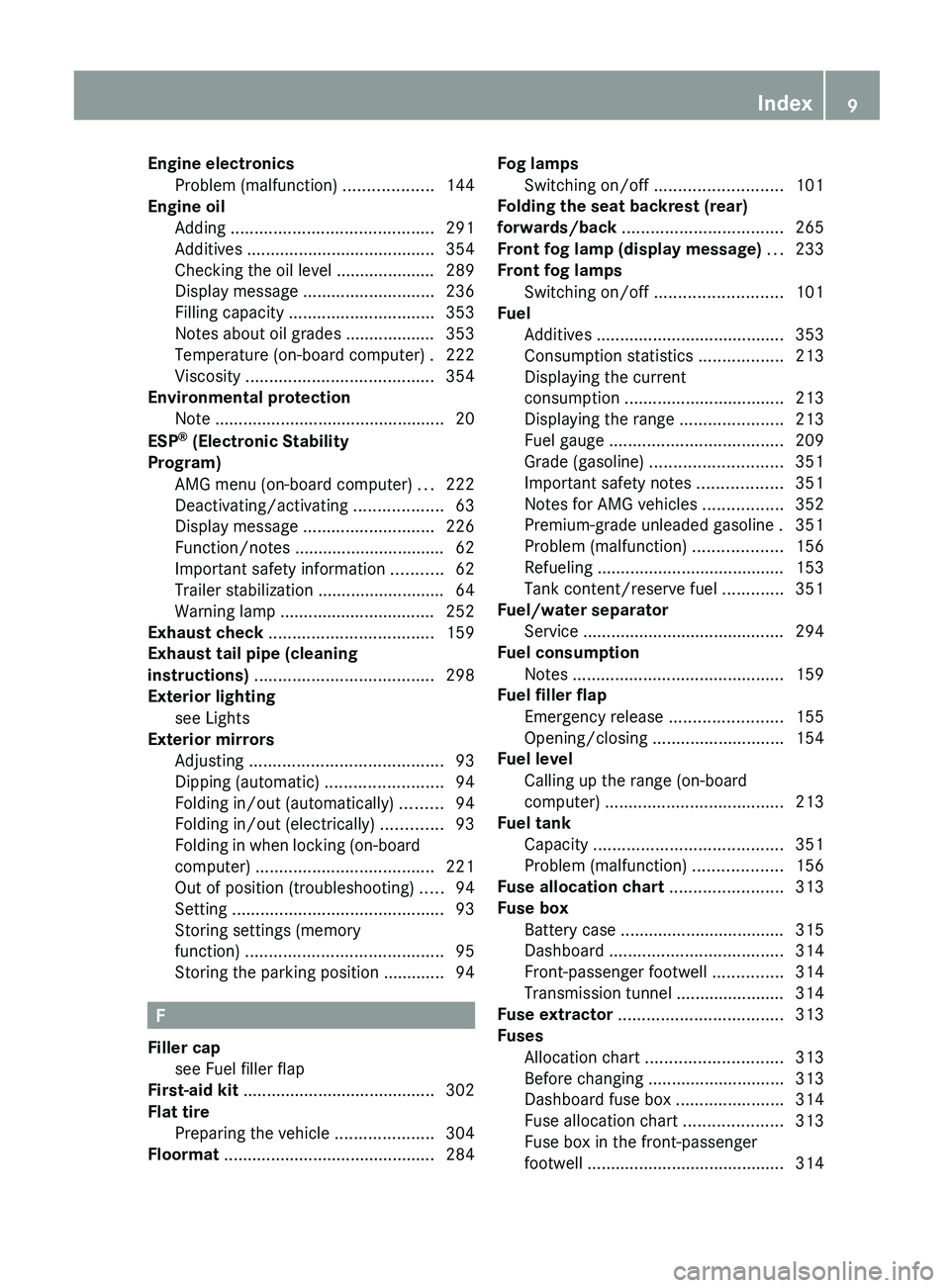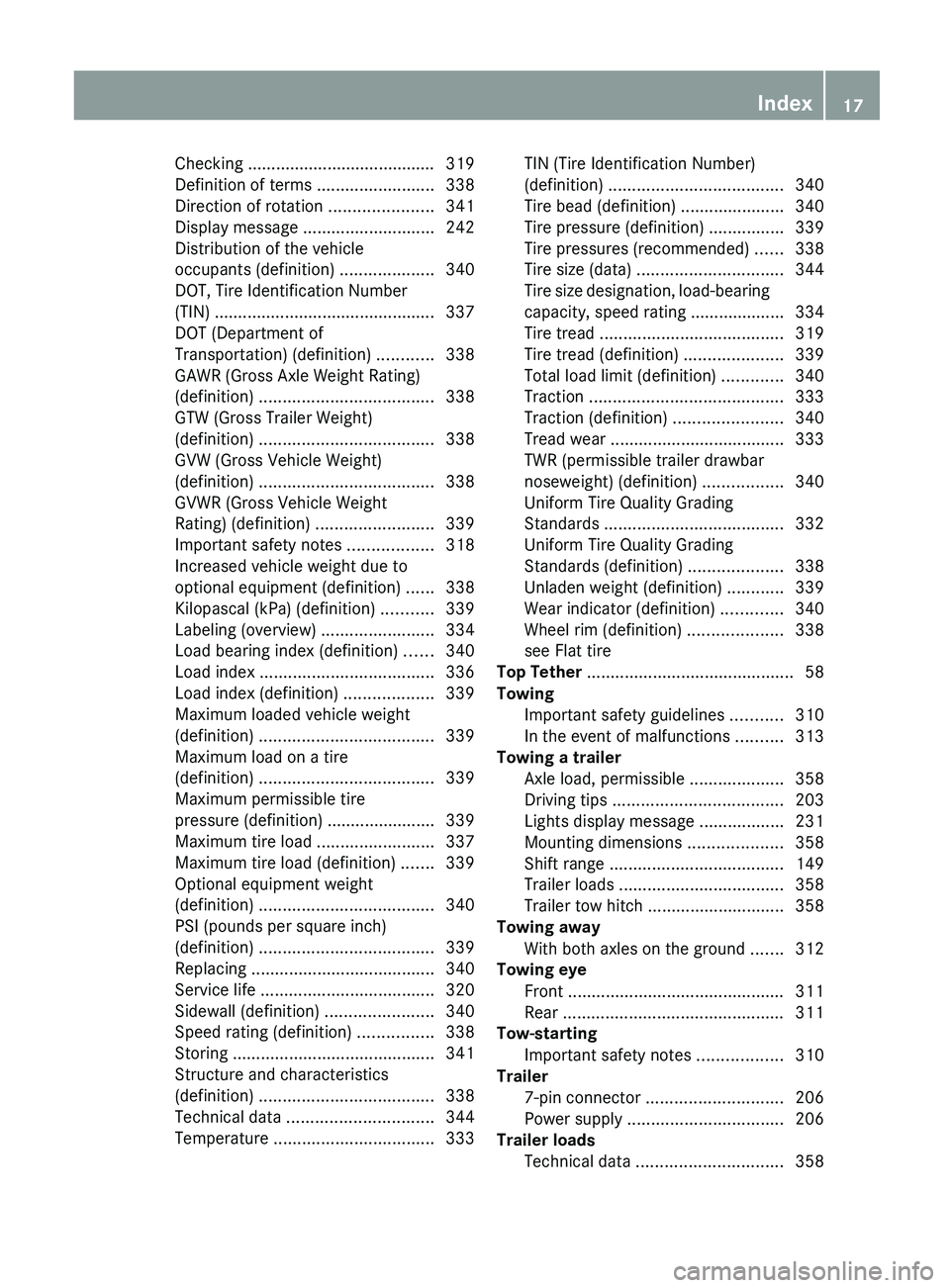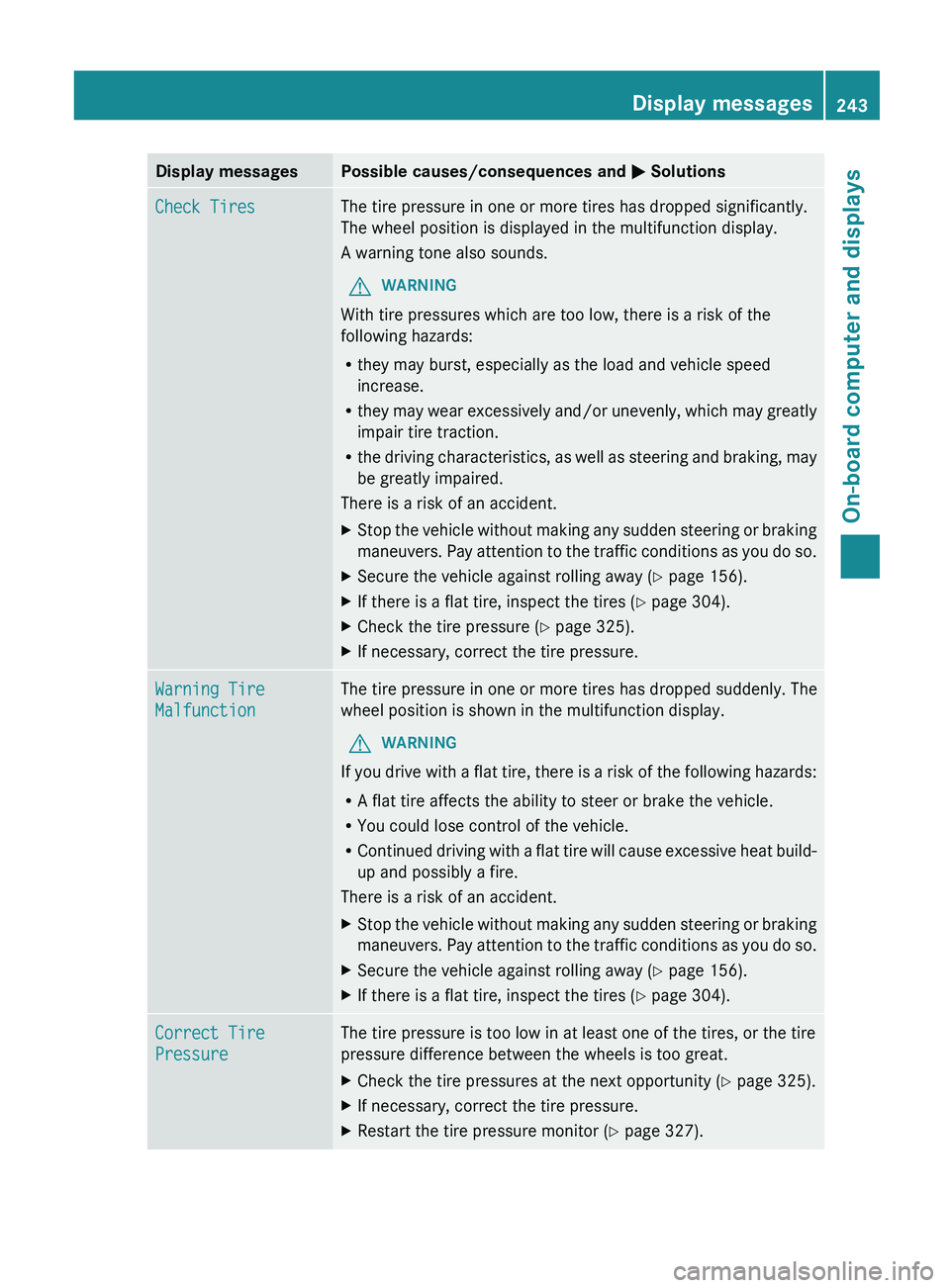2013 MERCEDES-BENZ G-CLASS SUV flat tire
[x] Cancel search: flat tirePage 7 of 364

Shift ranges
................................... 150
Steering wheel paddle shifters ...... 150
Trailer towing ................................. 149
Transmission position display
........146
Automatic transmission
emergency mode ............................... 153
Axle load, permissible (trailer
towing) ............................................... 358B
Backup lamp Changing bulbs .............................. 113
BAS (Brake Assist System) .................61
Battery Checking (SmartKey)
.......................70
Important safety guidelines
(SmartKey) ....................................... 70
Replacing (SmartKey) ...................... 71
Battery (vehicle)
Charging ........................................ 307
Display message ............................ 236
Important safety notes .................. 305
Jump starting ................................. 308
Overview ........................................ 305
Blind Spot Assist
Activating/deactivating ................. 218
Display message ............................ 240
Notes/function .............................. 186
see Active Blind Spot Assist
Brake fluid
Display message ............................ 229
Notes ............................................. 354
Brake fluid level ................................ 292
Brake lamps Adaptive ........................................... 62
Display message ............................ 232
Brakes
ABS .................................................. 61
BAS .................................................. 61
Brake fluid (notes) .........................354
Display message ............................ 226
Driving tips .................................... 159
High-performance brake system .... 161
Important safety notes .................. 159
Maintenance .................................. 160
Parking brake ................................ 157
Warning lamp ................................. 249 Breakdown
see Flat tire
see Towing away
Brush guard ....................................... 280
Bulbs Backup lamp .................................. 113
Brake lamp .................................... 113
Cornering light function .................110
Fog lamps ...................................... 110
Rear fog lamp ................................ 113
Tail lamp ........................................ 113
see Changing bulbs C
California Important notice for retail
customers and lessees ....................21
Calling up a malfunction
see Display messages
Care
Carpets .......................................... 300
Car wash ........................................ 295
Chrome parts ................................. 298
Display ........................................... 298
Gear or selector lever ....................299
Headlamps ..................................... 297
Interior ........................................... 298
Matte finish ................................... 296
Notes ............................................. 294
Paint .............................................. 296
Plastic trim .................................... 298
Power washer ................................ 295
Rear view camera .......................... 298
Roof lining ...................................... 300
Seat belt ........................................ 300
Seat covers .................................... 299
Sensors ......................................... 297
Steering wheel ............................... 299
Tail pipes ....................................... 298
Trim strips ..................................... 299
Washing by hand ........................... 295
Wheels ........................................... 296
Windows ........................................ 297
Wiper blades .................................. 297
Wooden trim .................................. 299 Index
5
Page 11 of 364

Engine electronics
Problem (malfunction) ...................144
Engine oil
Adding ........................................... 291
Additives ........................................ 354
Checking the oil level ..................... 289
Display message ............................ 236
Filling capacity
............................... 353
Notes about oil grades ................... 353
Temperature (on-board computer) . 222
Viscosity ........................................ 354
Environmental protection
Note ................................................. 20
ESP ®
(Electronic Stability
Program) AMG menu (on-board computer) ... 222
Deactivating/activating ................... 63
Display message ............................ 226
Function/notes ................................ 62
Important safety information ........... 62
Trailer stabilization ........................... 64
Warning lamp ................................. 252
Exhaust check ................................... 159
Exhaust tail pipe (cleaning
instructions) ...................................... 298
Exterior lighting see Lights
Exterior mirrors
Adjusting ......................................... 93
Dipping (automatic) .........................94
Folding in/out (automatically) ......... 94
Folding in/out (electrically) ............. 93
Folding in when locking (on-board
computer) ...................................... 221
Out of position (troubleshooting) .....94
Setting ............................................. 93
Storing settings (memory
function) .......................................... 95
Storing the parking position ............. 94 F
Filler cap see Fuel filler flap
First-aid kit ......................................... 302
Flat tire Preparing the vehicle .....................304
Floormat ............................................. 284Fog lamps
Switching on/off ........................... 101
Folding the seat backrest (rear)
forwards/back
.................................. 265
Front fog lamp (display message) ...233
Front fog lamps Switching on/off ........................... 101
Fuel
Additives ........................................ 353
Consumption statistics ..................213
Displaying the current
consumption .................................. 213
Displaying the range ...................... 213
Fuel gauge ..................................... 209
Grade (gasoline) ............................ 351
Important safety notes .................. 351
Notes for AMG vehicles ................. 352
Premium-grade unleaded gasoline . 351
Problem (malfunction) ...................156
Refueling ........................................ 153
Tank content/reserve fuel .............351
Fuel/water separator
Service ........................................... 294
Fuel consumption
Notes ............................................. 159
Fuel filler flap
Emergency release ........................ 155
Opening/closing ............................ 154
Fuel level
Calling up the range (on-board
computer) ...................................... 213
Fuel tank
Capacity ........................................ 351
Problem (malfunction) ...................156
Fuse allocation chart ........................313
Fuse box Battery case ................................... 315
Dashboard ..................................... 314
Front-passenger footwell ...............314
Transmission tunnel ....................... 314
Fuse extractor ................................... 313
Fuses Allocation chart ............................. 313
Before changing ............................. 313
Dashboard fuse box ....................... 314
Fuse allocation chart ..................... 313
Fuse box in the front-passenger
footwell .......................................... 314 Index
9
Page 19 of 364

Checking ........................................ 319
Definition of terms .........................
338
Direction of rotation ...................... 341
Display message
............................ 242
Distribution of the vehicle
occupants (definition) .................... 340
DOT, Tire Identification Number
(TIN) ............................................... 337
DOT (Department of
Transportation) (definition) ............ 338
GAWR (Gross Axle Weight Rating)
(definition) ..................................... 338
GTW (Gross Trailer Weight)
(definition) ..................................... 338
GVW (Gross Vehicle Weight)
(definition) ..................................... 338
GVWR (Gross Vehicle Weight
Rating) (definition) .........................339
Important safety notes .................. 318
Increased vehicle weight due to
optional equipment (definition) ...... 338
Kilopascal (kPa) (definition) ........... 339
Labeling (overview) ........................ 334
Load bearing index (definition) ...... 340
Load index ..................................... 336
Load index (definition) ...................339
Maximum loaded vehicle weight
(definition) ..................................... 339
Maximum load on a tire
(definition) ..................................... 339
Maximum permissible tire
pressure (definition) ....................... 339
Maximum tire load ......................... 337
Maximum tire load (definition) .......339
Optional equipment weight
(definition) ..................................... 340
PSI (pounds per square inch)
(definition) ..................................... 339
Replacing ....................................... 340
Service life ..................................... 320
Sidewall (definition) .......................340
Speed rating (definition) ................ 338
Storing ........................................... 341
Structure and characteristics
(definition) ..................................... 338
Technical data ............................... 344
Temperature .................................. 333TIN (Tire Identification Number)
(definition) .....................................
340
Tire bead (definition) ......................340
Tire pressure (definition) ................ 339
Tire pressures (recommended)
......338
Tire size (data) ............................... 344
Tire size designation, load-bearing
capacity, speed rating .................... 334
Tire tread ....................................... 319
Tire tread (definition) .....................339
Total load limit (definition) ............. 340
Traction ......................................... 333
Traction (definition) ....................... 340
Tread wear ..................................... 333
TWR (permissible trailer drawbar
noseweight) (definition) .................340
Uniform Tire Quality Grading
Standards ...................................... 332
Uniform Tire Quality Grading
Standards (definition) .................... 338
Unladen weight (definition) ............ 339
Wear indicator (definition) .............340
Wheel rim (definition) .................... 338
see Flat tire
Top Tether ............................................ 58
Towing Important safety guidelines ...........310
In the event of malfunctions ..........313
Towing a trailer
Axle load, permissible .................... 358
Driving tips .................................... 203
Lights display message .................. 231
Mounting dimensions .................... 358
Shift range ..................................... 149
Trailer loads ................................... 358
Trailer tow hitch ............................. 358
Towing away
With both axles on the ground ....... 312
Towing eye
Front .............................................. 311
Rear ............................................... 311
Tow-starting
Important safety notes .................. 310
Trailer
7-pin connector ............................. 206
Power supply ................................. 206
Trailer loads
Technical data ............................... 358 Index
17
Page 161 of 364

Drive sensibly – save fuel
Observe the following tips to save fuel:
X
The tires should always be inflated to the
recommended tire pressure.
X Remove unnecessary loads.
X Remove roof carriers when they are not
needed.
X Warm up the engine at low engine speeds.
X Avoid frequent acceleration or braking.
X Have all maintenance work performed at
the service intervals specified in the
Service Booklet or indicated
by the service
interval indicator.
Fuel consumption also increases when
driving in cold weather,
in stop-and-go traffic
and in mountainous terrain.
Drinking and driving G
WARNING
Drinking and driving and/or taking drugs and
driving are very dangerous combinations.
Even a small amount of alcohol or drugs can
affect your reflexes, perceptions and
judgment.
The possibility of a serious or even fatal
accident are greatly increased
when you drink
or take drugs and drive.
Do not drink or take drugs and drive or allow
anyone to drive who has been drinking or
taking drugs.
Pedals G
WARNING
Objects in the driver's footwell can restrict the
pedal travel or obstruct a depressed pedal.
The operating and road safety of the vehicle
is jeopardized. There is a risk of an accident.
Make sure that all objects in the vehicle are
stowed correctly, and that they cannot enter
the driver's footwell. Install the floormats
securely and as specified in order to ensure
sufficient clearance for the
pedals. Do not use
loose floormats. Exhaust check G
WARNING
Inhalation of exhaust gas is hazardous to your
health. All exhaust gas contains carbon
monoxide (CO), and inhaling it can cause
unconsciousness and possible death.
Do not run the
engine in confined areas (such
as a garage) which are not properly ventilated.
If you think that exhaust gas fumes are
entering the vehicle while driving, have the
cause determined and corrected
immediately. If you must drive under these
conditions, drive only with at least one
window fully open at all times.
Certain engine systems are designed to keep
the level of poisonous components in exhaust
fumes within legal limits.
These systems only work at peak efficiency if
they are serviced exactly in accordance with
the manufacturer's specifications. For this
reason, all work on the engine should only be
carried out by qualified and authorized
Mercedes-Benz technicians.
The engine settings must not be changed
under any circumstances. Furthermore, all
specific service work must be carried out at
regular intervals and in accordance with the
Mercedes-Benz service requirements. Details
can be found in the Maintenance Booklet. Braking
Important safety notes G
WARNING
If you activate the LOW off-road gear while
driving on a slippery
road surface, the wheels
may lose traction:
R if you remove your foot from the
accelerator pedal when driving
R if off road ABS intervenes when braking
If the wheels lose traction. the vehicle can no
longer be steered. There is an increased
danger of skidding and accidents. Driving tips
159
Driving and parking
Z
Page 165 of 364

R
Switch off the air-conditioning system.
R
R Shift the transfer case to LOW
RANGE(Y page 198).
R Engage the differential locks, if necessary
(Y page 201).
R Restrict the shift range to 1 or
2(Y page 150).
R Avoid high engine speeds.
R Enter and exit the
water at a flat place and
at a steady walking pace.
R Drive slowly and at an even speed through
the water.
R Do not stop and do not switch off the
engine.
R Water offers a high degree of resistance,
and the ground is slippery and in some
cases unstable. Therefore, it is difficult and
dangerous to pull away in the water.
R Ensure that a bow wave does not form as
you drive.
R Clean any mud from the tire tread after
fording.
R Apply the brakes to dry them after fording.
R Water offers a high degree of resistance,
and the ground is slippery and in some
cases unstable. Therefore, it is difficult and
dangerous to pull away in the water.
R Ensure that a bow wave does not form as
you drive.
R Clean any mud from the tire tread after
fording.
R Apply the brakes to dry them after fording. Winter driving
General notes G
DANGER
If the exhaust pipe is blocked or adequate
ventilation is not possible, poisonous gases
such as carbon monoxide
(CO) may enter the
vehicle. This is the case, e.g. if the vehicle becomes trapped in snow. There is a risk of
fatal injury.
If you leave
the
engine or the auxiliary heating
running, make sure the exhaust pipe and area
around the vehicle are clear of snow. To
ensure an adequate supply of fresh air, open
a window on the side of the vehicle that is not
facing into the wind. G
WARNING
If snow chains are installed to the front
wheels, they may drag against the vehicle
body or chassis components. This could
cause damage to the vehicle or the tires.
There is a risk of an accident.
To avoid hazardous situations:
R never install snow chains to the front
wheels
R always install snow chains in pairs to the
rear wheels.
Have your vehicle winterproofed
at a qualified
specialist workshop at the onset of winter.
Observe the notes in the "Winter operation"
section ( Y page 320).
Driving with summer tires Observe the notes in the "Winter operation"
section (
Y page 320).
Slippery road surfaces G
WARNING
If you shift down on a slippery road surface in
an attempt to increase the engine's braking
effect, the drive wheels could lose their grip.
There is an increased danger of skidding and
accidents.
Do not shift down for additional engine
braking on a slippery road surface. G
WARNING
The outside temperature indicator is not
designed to serve as an ice-warning device
and is therefore unsuitable for that purpose. Driving tips
163
Driving and parking
Z
Page 245 of 364

Display messages Possible causes/consequences and
0050 SolutionsCheck Tires The tire pressure in one or more tires has dropped significantly.
The wheel position is displayed in the multifunction display.
A warning tone also sounds.
G WARNING
With tire pressures which are too low, there is a risk of the
following hazards:
R they may burst, especially as the load and vehicle speed
increase.
R they may wear
excessively
and/or unevenly, which may greatly
impair tire traction.
R the driving characteristics, as well as steering and braking, may
be greatly impaired.
There is a risk of an accident.
X Stop the vehicle without making any sudden steering or braking
maneuvers. Pay attention to
the traffic conditions as you do so.
X Secure the vehicle against rolling away ( Y page 156).
X If there is a flat tire, inspect the tires ( Y page 304).
X Check the tire pressure (Y page 325).
X If necessary, correct the tire pressure. Warning Tire
Malfunction The tire pressure in one or more tires has dropped suddenly. The
wheel position is shown in the multifunction display.
G WARNING
If you drive with a flat tire, there is a risk of the following hazards:
R A flat tire affects the ability to steer or brake the vehicle.
R You could lose control of the vehicle.
R Continued driving with
a
flat tire will cause excessive heat build-
up and possibly a fire.
There is a risk of an accident.
X Stop the vehicle without making any sudden steering or braking
maneuvers. Pay attention to
the traffic conditions as you do so.
X Secure the vehicle against rolling away ( Y page 156).
X If there is a flat tire, inspect the tires ( Y page 304).Correct Tire
Pressure The tire pressure is too low in at least one of the tires, or the tire
pressure difference between the wheels is too great.
X
Check the tire pressures at the next opportunity (Y page 325).
X If necessary, correct the tire pressure.
X Restart the tire pressure monitor (Y page 327). Display messages
243
On-board computer and displays Z
Page 246 of 364

Display messages Possible causes/consequences and
0050 SolutionsTirePress.
Sensor(s) Missing There is no signal from the tire pressure sensor of one or several
wheels. The pressure of the affected tire is not displayed in the
multifunction display.
X
Have the faulty tire pressure sensor replaced at a qualified
specialist workshop. Tire Press.
Monitor Currently
Unavailable Due to a source of radio interference, no signals can be received
from the wheel sensors. The tire pressure monitor is temporarily
malfunctioning.
X
Drive on.
The tire pressure
monitor
restarts automatically as soon as the
problem has been solved. 0077
Tire Pressure
Warning Tire
Failure The tire pressure in one or more tires has dropped suddenly.
A warning tone also sounds.
G WARNING
If you drive with a flat tire, there is a risk of the following hazards:
R A flat tire affects the ability to steer or brake the vehicle.
R You could lose control of the vehicle.
R Continued driving with
a
flat tire will cause excessive heat build-
up and possibly a fire.
There is a risk of an accident.
X Stop the vehicle without making any sudden steering or braking
maneuvers. Pay attention to
the traffic conditions as you do so.
X Secure the vehicle against rolling away ( Y page 156).
X If there is a flat tire, inspect the tires ( Y page 304).244
Display messages
On-board computer and displays
Page 247 of 364

Display messages Possible causes/consequences and
0050 Solutions0077
Check Tire Pressure The tire pressure in one or more tires has dropped significantly.
G WARNING
With tire pressures which are too low, there is a risk of the
following hazards:
R they may burst, especially as the load and vehicle speed
increase.
R they may wear
excessively
and/or unevenly, which may greatly
impair tire traction.
R the driving characteristics, as well as steering and braking, may
be greatly impaired.
There is a risk of an accident.
X Stop the vehicle without making any sudden steering or braking
maneuvers. Pay attention to
the traffic conditions as you do so.
X Secure the vehicle against rolling away ( Y page 156).
X If there is a flat tire, inspect the tires ( Y page 304).
X Check the tire pressure (Y page 325).
X If necessary, correct the tire pressure. 0077
Correct Tire
Pressure The tire pressure is too low in at least one of the tires, or the tire
pressure difference between the wheels is too great.
X
Check the tire pressures at the next opportunity (Y page 325).
X If necessary, correct the tire pressure. Vehicle
Display messages Possible causes/consequences and
0050 SolutionsShift to 'P' or
'N' to Start
Engine You have attempted to start the engine with the transmission in
position R or D.
X
Shift the transmission to position P or N.Auxiliary Battery
Malfunction The auxiliary battery for the automatic transmission is no longer
being charged.
X
Visit a qualified specialist workshop at the next opportunity.
X Until then, set the automatic transmission to position P before
you switch off the engine.
X Before leaving the vehicle, apply the parking brake. Display messages
245
On-board computer and displays Z